As an Amazon Associate I earn from qualifying purchases.
Smoked venison roast sounds like it should be awful, but when you smoke venison just to doneness, medium-rare or medium, it can be an amazing cut of meat, both for dinners and for lunches with the leftovers.
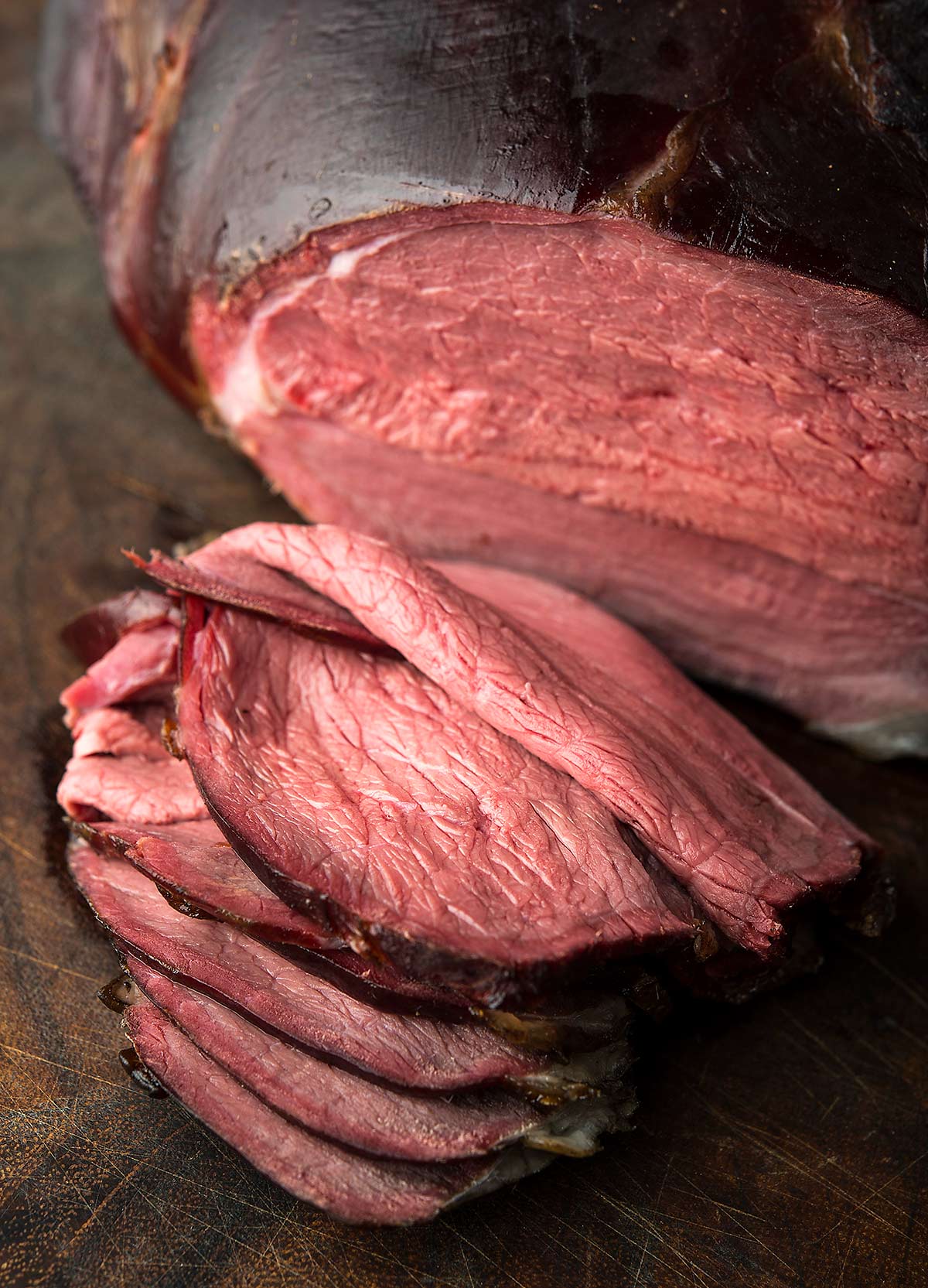
if you’re used to smoking pork, you’ll need to change your perspective. Smoked, pulled pork, gently cooked for many hours until it falls apart is one of the great things about being alive. But you can’t do that with venison, alas. Pork is, well, fatty. Porky, with lots of little packets of fat in between the muscle fibers that means a slow-smoked pork shoulder will baste itself.
Deer are lean, especially when you get to the interior of a cut. And fat, as you may know, is insulation — and insurance policy against cooking too long — so the fact that a venison ham has none means it can go from sublime to dog food in a matter of minutes.
So is there no way to properly make smoked venison roast? There is indeed, but you have to shift your barbecue compass to the West, to Central California, to be specific.
The only contribution California makes to the barbecue universe is called Santa Maria Barbecue, normally done with beef tri-tip, a cut from the lower part of the cow’s hind leg. It is wonderful stuff, smoky with a lovely spice rub. But here’s the thing: Santa Maria BBQ, or what we here in Cali just call “tri-tip,” is never cooked past medium. To do so is a sin.
Venison roasts, typically single-muscle roasts or those with just a few muscles — from the hind leg — are what you want when you make smoked venison. You make smoked venison backstrap similarly.
How do you get there? You can do what I call “smoke roasting” — I have a method for this in my cookbook Buck, Buck, Moose. That consists of tossing a hunk of meat into a hot smoker and cooking it until the meat hits the proper internal temperature.
Incidentally, if you don’t want to go through the multi-day salting and curing of the venison roast, you can use this recipe for reverse seared venison roast and get a similar result in one day. And if you are working with bison, which has tastier fat, you can make a full-on, Texas style smoked bison brisket.
To really make a nice smoked venison roast, you will want to salt it first. Not a full-on cure, but a nice salting.
You get there by using your digital kitchen scale. Yes, you must measure things for this recipe. You measure your hunk of venison. Do this in grams. Then you measure out 1 percent of that weight in regular kosher salt, and add an equal amount of sugar. If you feel like using a curing salt — I don’t — add no more than 0.2 percent of the venison’s weight. You’ll want a cure marked No. 1 here, not No. 2. Again, I don’t use curing salts, but you can.
Mix your salt and sugar together and get yourself a big tub or somesuch so you don’t lose any of it. Now you massage the salt/sugar into the venison, taking care to get it around the femur if you’re doing a whole leg, which is a cool thing to do if you have a teeny deer; the one in the pictures is an Arizona Coues deer buck.
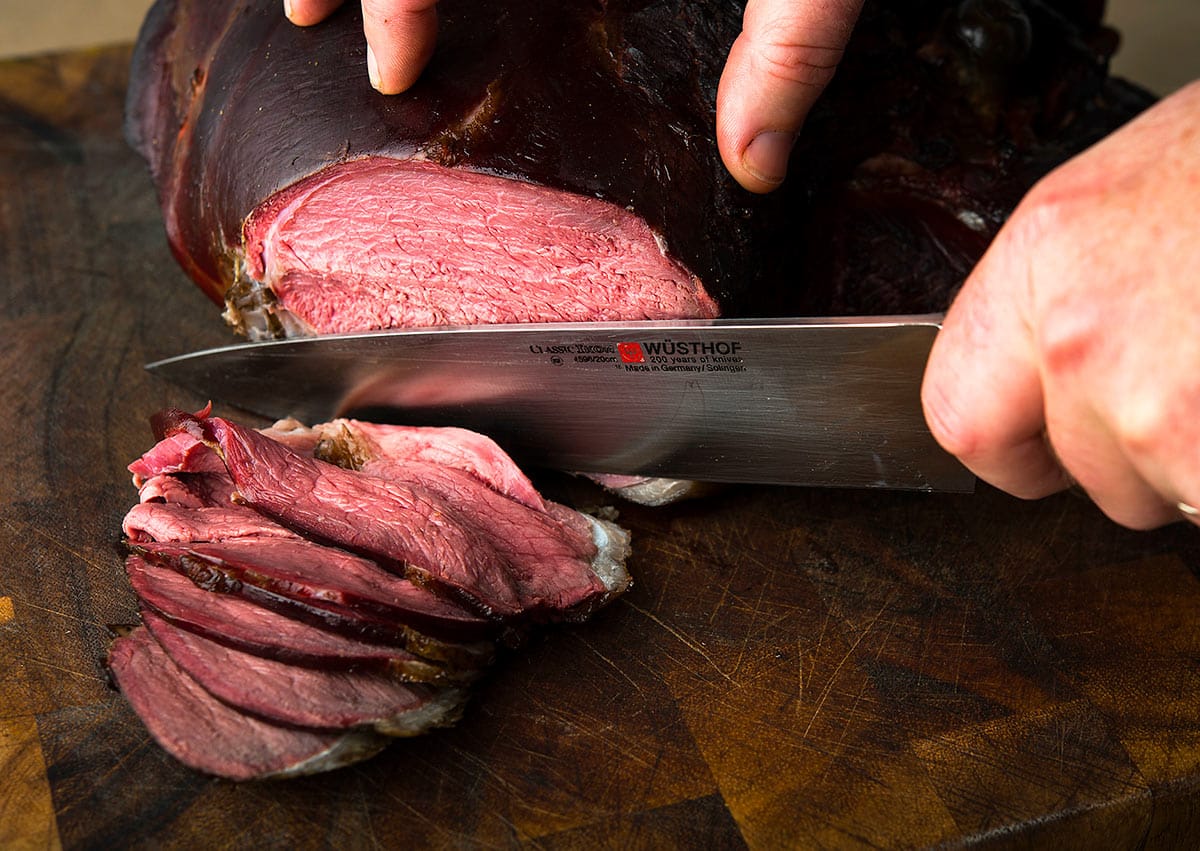
Now put your venison and any remaining cure into a big bag and set it in the fridge. How long? Two days per pound of venison. If you are going to err, err on the side of more time. When you’re ready, rinse the meat off, pat it dry and, if you want, let it sit uncovered in the fridge an extra day. You can skip this if you want, but it helps make the meat smokier.
Then you smoke the roast slow and low until the thickest part hits the temperature you want. I prefer 130 to 135°F. How do you know? You need an internal probe thermometer. I happen to have one that comes with the Traeger I use.
Wood choice is your own. I prefer fruit woods, but will use oak or hickory, too, depending on my mood. (The Traeger has all sorts of wood pellets you can use.)
That’s it. Measure your venison, lightly cure it in the fridge a few days, smoke it slow and low until it hits the right temperature, let it rest 10 minutes on the cutting board. Slice and eat.
This smoked venison roast is basically the best “roast beef” you’ve ever eaten. Don’t believe me? Try it.
Smoked Venison Roast
Ingredients
- One 5- pound venison roast (See notes below)
- 23 grams kosher salt, about 0.8 ounces
- 23 grams sugar, about 0.8 ounces
Instructions
- Mix the salt and sugar together and massage the mixture into every part of the venison. Do this over some sort of tub or container - a baking sheet works well - so you don't lose any. Put everything, including any stray cure mixture, into a large plastic bag or container that will just about hold the venison. Let this sit in the fridge anywhere from a week to 10 days. Turn the meat over once a day.
- Rinse off the meat and pat it dry. If you want, you can set the venison on a rack uncovered in the fridge for a day before smoking.
- Smoke the meat slow and low - I prefer somewhere between 175°F and 200°F - with an internal probe thermometer stuck in the thickest part of the venison. Do not let the probe hit bone. Smoke for between 2 and 5 hours, or until it hits an internal temperature of no lower than 120°F and no higher than 140°F. I prefer about 130°F.
- Let the smoked venison sit on the cutting board 10 to 15 minutes before slicing and serving. It will keep a week in the fridge and freezes well.
Notes
Nutrition
Nutrition information is automatically calculated, so should only be used as an approximation.
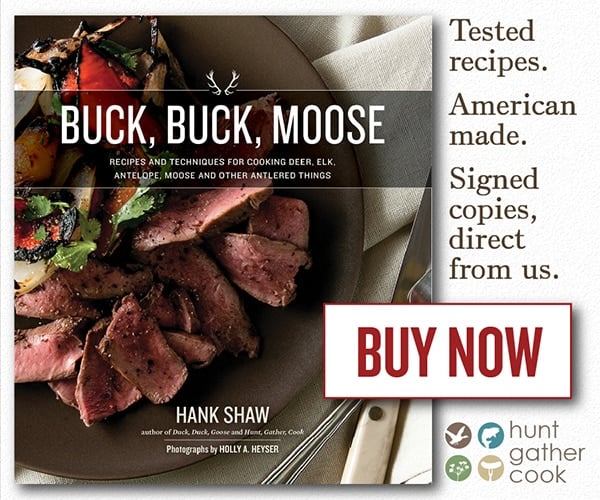


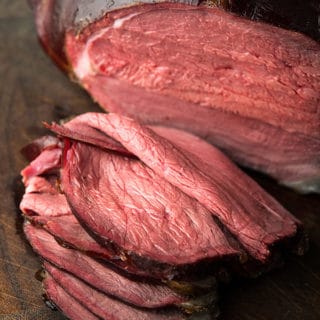

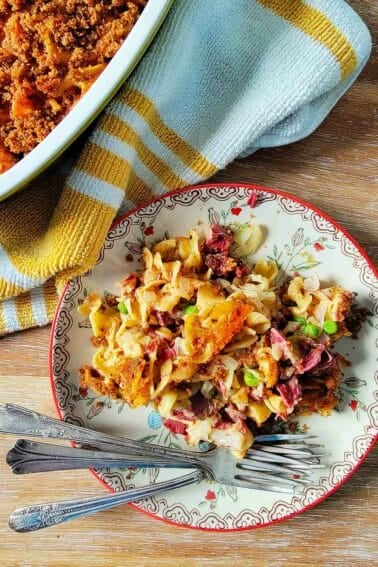
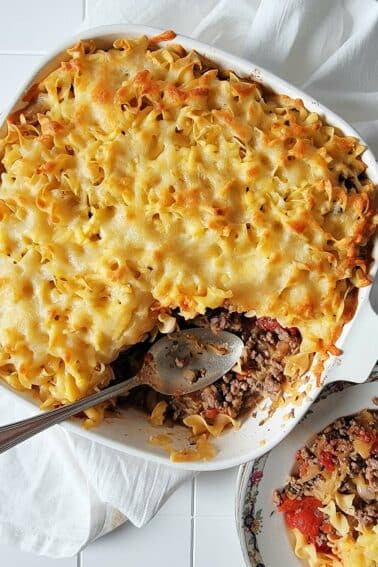
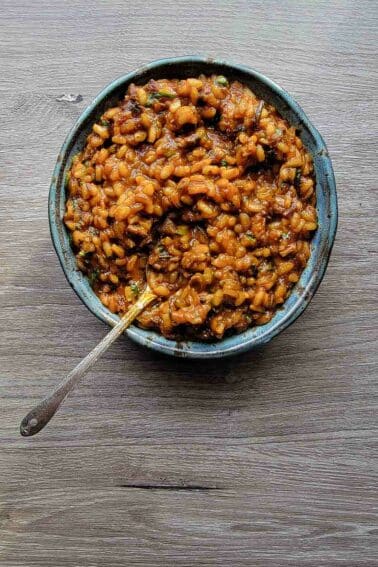
I do everything you say about the salt and sugar but I sear the roast over a charcoal fire on all sides, then move it to the side of the fire for a couple of hours or however long to get it to about 135 degrees. Too good
Just did 3# venison rump roast after 2 week in salt and maple syrup for the sugar. Apple wood smoke. What an excellent treat it is. Taking to SD for lunch meat while pheasant hunting!
Thanks Hank, love your recipes.
Hi Hank, have all the books and use the web site regularly. Haven’t had a recipe fail yet! 2 questions on this one. Will brown sugar be a 1:1 for white sugar? And any recommendations on a rub for a Christmas ham/roast on this recipe? Or is it just perfect as is in your opinion?
Randy: Yes, you can sub in brown sugar 1:1 on this one. For a rub, maybe massage in ground black pepper, coriander seed and crushed allspice?
Perfect thanks!
We ALWAYS very very slow roast our own 100% grass fed lamb legs. (So, little fat). Anywhere from 5-7 hours at 200F in a Dutch oven, depending on how big the lamb leg is or how old the lamb/sheep is. It doesn’t really overcook at that temp. It just falls off the bone. We do rub it with salt, herbs like mint or sage or rosemary if desired, no sugar, and we do put potatoes and onions underneath it. It is pretty divine, with zero work.
This recipe is the real deal… use it on all my elk and venison roasts… don’t need anything else (I’ve tried). Even overnight in the fridge with the salt/sugar is enough, though the longer the better.
Hank I’ve got your book and it really is creating some great new ideas.
I’ve a question, normally I separate the hind leg by muscle group . This time I used a processor and he mistakenly gave me a whole boned out Axis that weighs 3 1/2 lbs. I divided one and got a decent roast but the smaller portions I had to use as medallions.
My question is what about the connective tissues and internal silver skin. If I cook the leg whole do you just carve the main part and then separate the other when you see it?
PS I’ve had every type of venison ( including Africa) except Moose and far and away is if you can get to South Texas is Nilgai !
Lew: Yes, on an axis the connective tissue shouldn’t be too bad. And I love nilgai! I’ve shot one and eaten many.
Hello Hank just looking for your opinion here. This years moose harvest is carrying a tapeworm parasite. Now I’ve been told just to cook all the meat well done and everything will be fine. My question to you is if the meat been frozen solid should it not be safe to eat a medium rare steak or do you recommend cooking it well done also look forward to a response thanks Bryan
Bryan: I actually don’t know on this one. With fish, yes, that tapeworm larva dies. I don’t know what variety of tapeworm might be in the moose. Maybe try finding out what species from the Fish & Game Dept. and Googling to see if freezing kills it.
Hank, I need some help. I didn’t read carefully about the shorter times for kosher salt and thought I needed a week to cure. I started two 2 lbs roasts but don’t have people coming for a week. Will they be ok or do you have any suggestions for how to keep them good for that long? Push comes to shove I will just cook them during the week. Thanks.
Ben: I would rinse them off in a couple days, pat them dry and vac seal them until the time comes to cook.
This was easily the best thing I have ever smoked! I cooked one roast to 130 and the other to 140. Both were insane. Thanks Hank!
32 grams seems rather low for a 5 pound venison rear leg?
I’m doing the smoked venison roast this weekend. It is curing as we speak. I will be adding a spice rub to your recipe. Question, if I rinse the cure then pat dry then fan dry for about 3 hours to develop pellicle, should I dry rub before fan dry or after? Thinking about placing rub on and then back to fridge overnight before smoking. Is that legit?
Joel: Put the dry rub on after rinsing, but before drying. Yes, rinse, do the rub, set in the fridge overnight will work well.
Hi Hank, What is the reason for washing off the cure before smoking?
Many thanks,
Cam
Cam: So it is not too salty.
Hank,
I am in day 2 of the cure in my fridge and alit of liquids are coming out of the meat. Should I let tit be or drain off the liquid ?
Rhett: I’d drain it off.
After very good results with your smoked venison backstrap recipe last week, I smoked about 7.5 pounds of hind-quarter venison in separated hunks. My wife and a widow neighbor are delighted with the tenderness and flavor of the meat. I rested it after smoking, then sliced it before storing overnight. Best venison ever.
This is my first time trying this. My son gave me a couple small roasts and I froze them. I see that it will take longer and will need to wait, but mine are only 1.5 and 2 lbs so will I need to “cure” them as long as your 5lbs example ?
Paul: No, I think 24 hours would be enough.
I’m assuming the salt keeps this from spoiling while it is salting for the 7-10 days? This makes sense but at the same time you mention it isn’t a full cure, so I just want to make sure I’m safe to leave my 3.5 lb roast in the fridge for 7 days (I’d normally only keep fresh meat a few days before cooking).
Brock: Yes, the salt keeps it in good shape. If you are not using curing salt, you can pull it after as little as 3 days. The longer time is with curing salt because it takes time for it to permeate to the middle.
Presuming you had clean butchering skills, and the meat was cooled properly after kill, It will be completely safe in a cool +4c for longer than 7 days.
Remember the red stuff in poly packs at the supermarket probably is older than 7 days with dubious handling along it’s way to you.
Do I leave the silver skin on when doing this? I’m tempted to try this with a whole deer hind quarter.
Sam: I always trim the heavy stuff. The fine silverskin is OK to leave on, but if you do have the time, yes, trim it.
Hank I love the idea of doing this and I’ve got my 5lb leg of Scottish roe deer curing in the fridge.
My concern is that I’m going to be smoking it using a Big Green Egg and your temperature range is well below anything I’ve done before.
The egg is pretty happy to sit around 130 degrees Celsius. Do you have any tips for running it at 75, which is the Celsius equivalent of your lowest temperature.
Any advice would be greatly appreciated
Thanks
Tim, neither have I got an egg ? nor have I as yet warm smoked a leg of (in my case N. German) roe deer but I do warm smoke salmon at similar temps on a water smoker. I set up a minion ring and to achieve a temp of roughly 75°C I would ignite about 15 briketts. (This is only a rough guide because the exact amount will depend upon your bbq, ambient temp, wind and type of briketts used). I use wood chunks for the smoke source and distribute them around the ring. As the burning of the ring slowly advances and each chunk ignites, you will probably experience a temporary rise in temp of a few degrees. Whereas that can be a problem with fish it shouldn’t be a problem with meat.
Good luck
//Stuart ?
PS
I’ve got a 2kg leg curing at the moment and I reckon to smoke it in just under 3 weeks time.
Thanks Stuart
I’ll give it a shot!
Made two small roasts( 3 lbs. each) on a Weber charcoal kettle grill. Used the slow and sear insert. Followed the curing instructions and rinsed, dried, stored in frig for 3 hours, then in the basement for 2 hours with a fan blowing on them to form the pellicle. Followed the slow and sear instructions to maintain a temp between 180-220. Used charcoal briquettes and applewood chunks for smoke. Pulled each piece when the internal temp reached 130(about 2-2 1/2 hours on the grill). Set each piece on a wire rack with multiple towel layers for close to an hour after pulling. Sliced thin and served with Susan Stamberg’s cranberry relish…..oh so good!
This was outstanding! I had no idea a venison roast could be so tender.
Always the best recipes
One of my favorite ways to prepare a venison roast. Slice and make sandwiches with horseradish sauce for lunches, can eat them all week and not get tired of them!